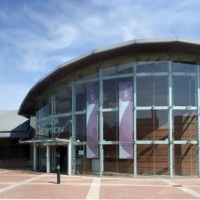
Wedgwood Museum
The Wedgwood company's founder, Josiah Wedgwood I, had the initial idea for preserving and curating a historical collection in 1774. A public museum dedicated to this purpose first opened in 1906, and moved to its present site in 2008. In 2009 the museum won the Art Fund Prize for Museums and Galleries. It underwent further redevelopment in 2015/16. The museum's rich collection of ceramics and archive material tell the story of Josiah Wedgwood, his family, and the business he founded over two centuries ago.
The collections at the museum make up one of the most significant single factory accumulations in the world. They contain a range of things from ceramics, archive material and factory equipment, to social history items that help interpret life in Georgian Britain. Key themes explored throughout the galleries include Wedgwood's links to royalty, the influence of nature on his work and his position as a successful entrepreneur.
On display in the museum also are a small collection of objects which relate to Wedgwood's prominent role in the campaign to abolish the British Slave Trade. Here, the display focusses on the production of the well-known antislavery medallion, which bears the 'Am I Not a Man and a Brother?' image. It also highlights Wedgwood's connection to Olaudah Equiano and the influence of proslavery factions in British society during the eighteenth and nineteenth century.
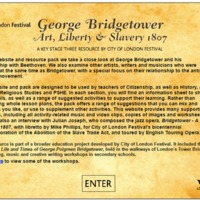
George Bridgetower: Art, Liberty and Slavery 1807
In this website and Key Stage 3 Resource Pack, the City of London Festival examined the work of the Afro-European violinist George Bridgetower (1778-1860) and, in particular, his relationship with the composer Ludwig van Beethoven. The resource also explored the role of other artists, writers and musicians who were active at the same time as Bridgetower, with a special focus on their relationships to the anti-slavery movement. The website provided music, video clips and worksheets, alongside an interview with Julian Joseph, composer of the jazz opera Bridgetower - A Fable of 1807, toured by English Touring Opera. The resource was part of a broader education project developed by City of London Festival, which included the exhibition, 1807: The Life and Times of George Polgreen Bridgetower, held in the walkways of London's Tower Bridge. The education project also included storytelling, music and creative writing workshops in secondary schools.
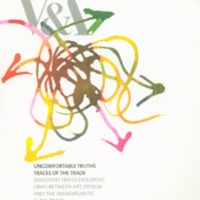
Uncomfortable Truths
Uncomfortable Truths at the Victoria and Albert Museum sought to expose how embedded the transatlantic slave trade was within British culture during the 18th and 19th centuries through art and design. A series of five trails - 'Traces of the Trade' - explored the permanent collections on display through the following themes: Consuming the Black Atlantic, Black Servants in British Homes, Britain and the West Indies, Representing Slavery and Abolitionism, Gold and Slaves Transnational Trade Links. An exhibition of contemporary art examined the impact of the legacies of slavery on modern art and design. The Victoria and Albert Museum commissioned new works by Yinka Shonibare, Romauld Hazoume, Julien Sinzogan and Keith Piper. These and other contemporary interventions by a total of 11 artists were displayed throughout the museum. This exhibition later toured to Ferens Art Gallery in Hull.
The 'Truth and Rights' season of events highlighted often untold stories of Black British heroes, including focus on the actor Ira Aldridge. Visitors were also offered discussions, debates, displays and an eight week free art course. A two-day conference, 'From Cane Field to Tea Cup: The Impact of the Transatlantic Slave Trade on Art and Design' focused on V&A collections took place in February 2007.
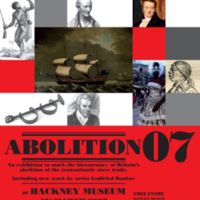
Abolition 07
Hackney Museum's Abolition 07 exhibition told the story of British involvement in the transatlantic slave trade, the resistance to it, and its abolition, and in particular emphasised the involvement of Hackney's residents in the abolition movement. The display included new artwork by Godfried Donkor in collaboration with young Hackney artists. A film of interviews with Hackney residents, Hear My Voice, was produced. Over 1200 children from Hackney Primary Schools took part in poetry workshops at the museum with poets Adisa and Baden Prince. Their poems and responses were published in the booklet 'And Still I Rise'.
The research into Hackney's connections to the transatlantic slave trade continued in 2013-2015 with 'Local Roots / Global Routes', a collaborative project between Hackney Museum and Archives and the Legacies of British Slave-ownership project.
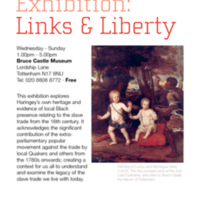
Links and Liberty
An exhibition at Bruce Castle Museum (in partnership with Euroart Studios) explored the transatlantic slave trade, Haringey's heritage relating to the trade and its legacy, and the historic Black presence in the borough from the 16th century onwards. There was a particular focus on the painting of Lucius and Montague Hare, sons of Lord Coleraine (former owner of Bruce Castle), with their African servant. The exhibition also looked at the extra-parliamentary popular movement against the trade by local Quakers such as Priscilla Wakefield and others. Contemporary dance workshops for secondary schools were led by dance company Movement Angol.
The Links and Liberty exhibition included 'Stolen', a life-size installation by artists at Euroart Studios (John Fowler, Lorraine Clarke and Nigel Young) of a section of a slave ship. School pupils were encouraged to climb inside to imagine conditions on board.
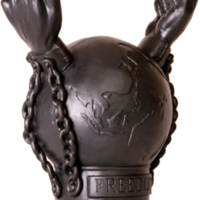
Abolition of the Slave Trade Act Commemorative Exhibitions
Nottingham Castle Museum held two exhibitions in 2007. Inspired by the anti-slavery medallion produced by Josiah Wedgwood in the 1790s, a group of young people from Nottingham’s African Caribbean community worked with artist Katherine Morling to explore issues surrounding slavery and the representation of black people in art. The group worked under the name Sankofa. The ceramic Globe of Freedom was fired at the Wedgwood factory in Staffordshire, and was displayed at Nottingham Castle Museum alongside the Wedgwood medallion. The word ‘FREEDOM’ is impressed on one side and ‘EQUALITY’ impressed on the other. A replica sculpture is still used as part of a handling collection loaned to schools and community groups in the Nottingham region. A second exhibition, in collaboration with the Open University in the East Midlands, looked at the British slave trade using slave narratives, telling the story of three survivors of slavery: Mary Prince, Robert Wedderburn and Quobna Ottobah Cugoano.
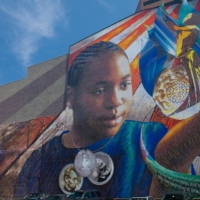
Lincoln Legacy
This large mural by Joshua Sarantitis, Lincoln Legacy, can be read from left to right, moving from Africa to America. The shape of Africa adorns the backdrop until the wooden boards of the slave ship transform into the American flag. Around the young child’s neck are three medallions: Abraham Lincoln’s face, Josiah Wedgwood’s abolitionist icon “Am I Not a Man and a Brother,” and Frederick Douglass' face. Made up of over 1 million glass mosaic tiles, it is the largest Venetian glass tile mural in Philadelphia at over 10,000 square feet. Located a block away from the Liberty Bell and Independence Mall, it is one of the few murals to be created in Philadelphia’s wealthier districts.